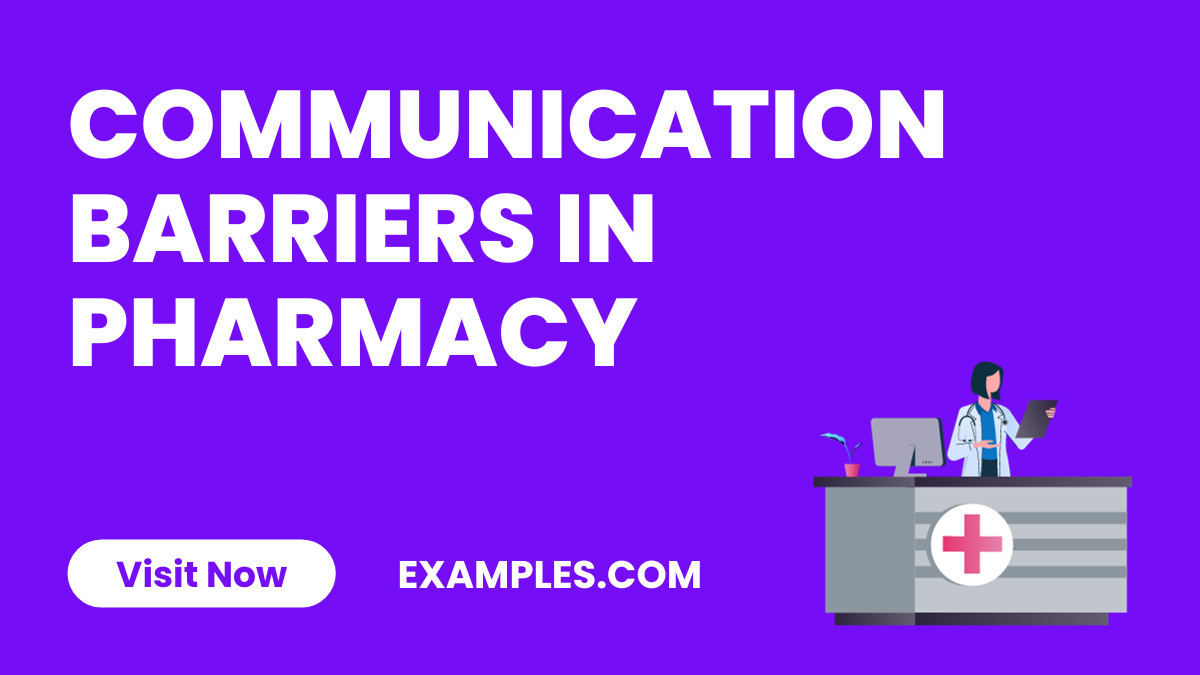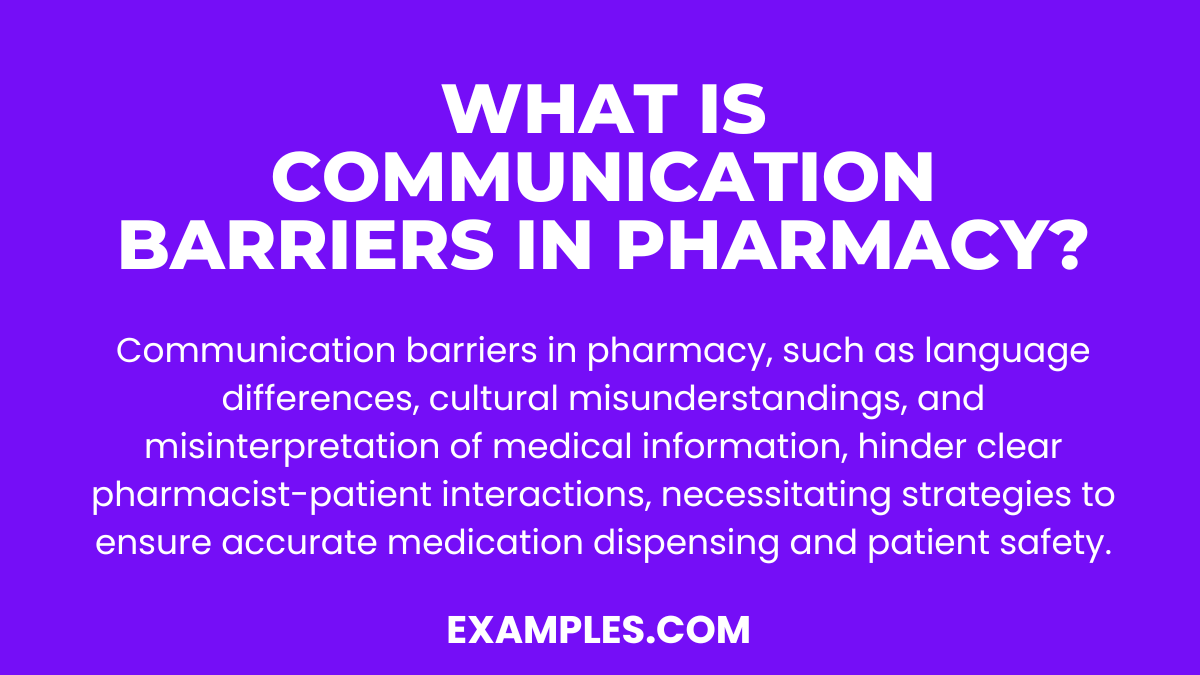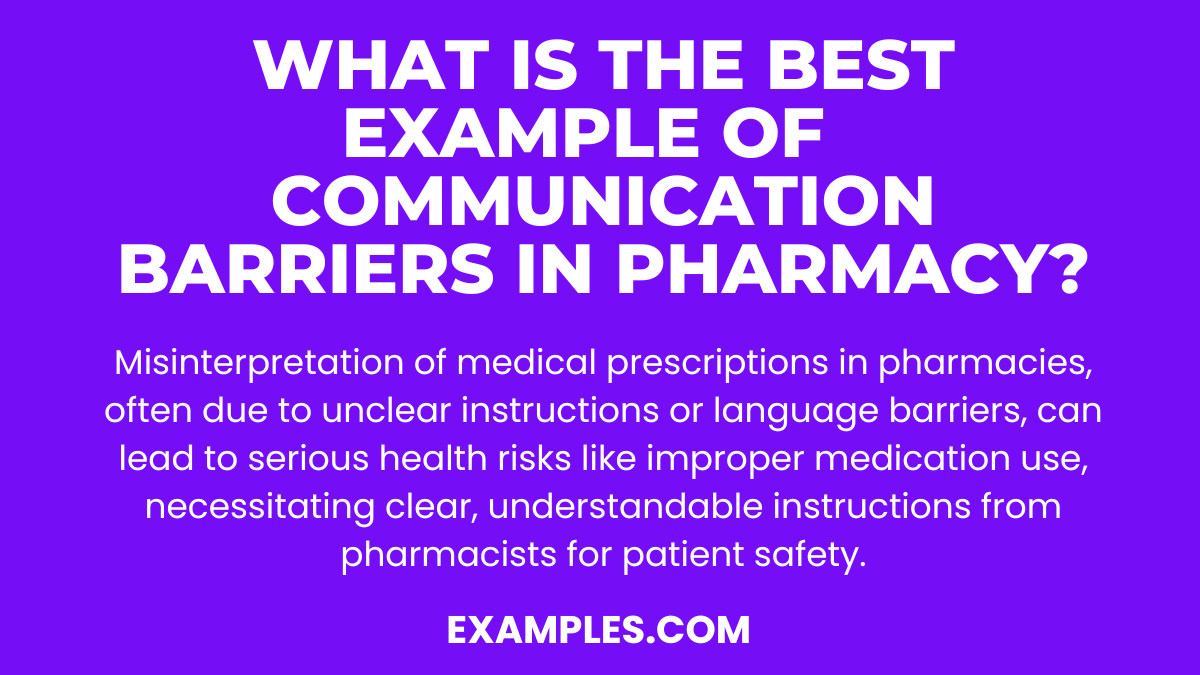30+ Communication Barriers in Pharmacy Examples
“Communication Barriers in Pharmacy” is a comprehensive guide that addresses the unique challenges faced in pharmacy communication. It includes communication examples that illustrate common issues like misinterpretation of medical prescriptions, language barriers in pharmacy services, and non-verbal cues in pharmacy interactions. This guide is essential for pharmacists, pharmacy students, and patients, offering insights into effective patient counseling techniques and strategies for overcoming medication miscommunication, ensuring better health outcomes and enhanced pharmaceutical care.
Download How can Pharmacy Overcome Communication Barriers PDF
What is Communication Barriers in Pharmacy?
Communication barriers in pharmacy refer to obstacles that impede clear and effective interaction between pharmacists and patients or other healthcare professionals. These barriers can include language differences, cultural misunderstandings, misinterpretation of medical information, and challenges in conveying complex medication instructions. Overcoming these barriers is crucial to ensure accurate medication dispensing, patient safety, and overall effective pharmaceutical care.
What is the best Example of Communication Barriers in Pharmacy?
One prominent example of communication barriers in pharmacy is the misinterpretation of medical prescriptions. This occurs when patients misunderstand the dosage, usage, or purpose of a medication due to unclear instructions or language barriers. This barrier can lead to serious health risks, including improper medication use. Addressing this issue involves pharmacists providing clear, understandable instructions, using simpler language, and ensuring patient comprehension to enhance medication safety and effectiveness.
Communication Barriers in Pharmacy Examples
In the field of pharmacy, communication barriers can significantly impact patient care. These barriers range from miscommunication about drug information to cultural misunderstandings between pharmacists and patients. It’s crucial for pharmacists to recognize and address these challenges to ensure accurate and safe medication use.
- Language Differences: Misunderstandings due to the patient’s native language differing from the pharmacist’s.
- Fix: Use translation services or bilingual staff.
- Technical Jargon: Using complex medical terms that patients don’t understand.
- Fix: Simplify explanations using layman’s terms.
- Hearing Impairments: Difficulty communicating with patients who have hearing issues.
- Fix: Use written communication or sign language interpreters.
- Cultural Misunderstandings: Cultural differences leading to misinterpretation of information.
- Fix: Culturally sensitive communication training for pharmacists.
- Health Literacy: Patients not understanding medical and pharmaceutical terms.
- Fix: Assess patient understanding and explain in an accessible way.
- Distractions in Pharmacy Environment: Noisy or busy environments leading to misheard information.
- Fix: Create a quiet space for patient consultations.
- Emotional Distress: Patients under stress may not comprehend instructions properly.
- Fix: Patient reassurance and follow-up communication.
- Visual Impairments: Challenges in reading prescription labels or written information.
- Fix: Offer large print or Braille labels, and verbal instructions.
- Misinterpretation of Non-Verbal Cues: Misreading body language or facial expressions.
- Fix: Training in understanding and using non-verbal communication effectively.
- Technological Barriers: Difficulty in using digital systems for prescriptions or information.
- Fix: Provide user-friendly technology and personal assistance when needed.
Addressing these barriers requires a combination of patient-centered communication, technology, and ongoing education for pharmacy professionals.
Communication Barriers in Pharmacy for Patients
Patients in pharmacies often encounter communication barriers that can affect their understanding and management of medications. These barriers include language difficulties, medical jargon, and a lack of personalized communication, impacting their overall healthcare experience.
- Language Differences: Patients might not speak the same language as the pharmacist.
- Example: “I asked for an interpreter to ensure I understood the medication instructions correctly.”
- Complex Medical Terms: Difficulty understanding medical terms used by pharmacists.
- Example: “The pharmacist used simpler terms to explain my medication, making it easier to understand.”
- Hearing Difficulties: Hard of hearing patients may miss important details.
- Example: “The pharmacist wrote down instructions for me, which was very helpful.”
- Low Health Literacy: Not understanding the implications of their condition or medication.
- Example: “The pharmacist used diagrams to explain how my medication works.”
- Visual Impairments: Trouble reading prescription labels or instructional pamphlets.
- Example: “They provided my prescription information in large print for easier reading.”
- Cultural Misunderstandings: Cultural differences can lead to misinterpretation of information.
- Example: “The pharmacist was sensitive to my cultural background, which made me feel more comfortable.”
- Fear or Embarrassment: Patients may be hesitant to ask questions.
- Example: “The pharmacist reassured me that all questions are valid and important.”
- Technological Barriers: Difficulty using digital tools for accessing pharmaceutical information.
- Example: “I received help with the online portal to access my prescription details.”
- Time Constraints: Feeling rushed and unable to discuss concerns fully.
- Example: “The pharmacist ensured I didn’t feel rushed and addressed all my questions.”
- Misinformation from External Sources: Confusion due to conflicting information from the internet or other sources.
- Example: “The pharmacist clarified the misinformation I found online about my medication.”
How can pharmacy overcome communication barriers?
To overcome communication barriers in pharmacy, several strategies can be implemented:
- Use Simple Language: Avoid medical jargon when explaining prescriptions to patients.
- Cultural Competence: Understand and respect cultural differences in communication styles.
- Active Listening: Ensure understanding of patient concerns and questions.
- Patient Education: Educate patients about their medications and health conditions.
- Visual Aids: Use diagrams and pictures for better comprehension.
- Translation Services: Provide for patients who speak different languages.
- Feedback Mechanisms: Encourage patient feedback to improve communication.
- Empathy and Patience: Show understanding and patience in all interactions.
- Clear Instructions: Provide clear, concise medication instructions.
- Training Programs: Regular staff training on communication skills.
- Technology Utilization: Use technology to aid in effective communication.
- Personalized Approach: Tailor communication to individual patient needs.
Implementing these strategies can significantly enhance the effectiveness of communication in pharmacy settings.
What are the barriers to effective communication in pharmacy practice?
Barriers to effective communication in pharmacy practice include:
- Language Differences: Challenges in understanding due to language barriers between pharmacists and patients.
- Medical Jargon: Use of complex medical terminology that patients may not understand.
- Cultural Misunderstandings: Cultural differences leading to misinterpretation of information or instructions.
- Health Literacy Issues: Patients’ lack of understanding of health and medical concepts.
- Hearing Impairments: Difficulty in communicating with patients with hearing problems.
- Emotional and Psychological Barriers: Patient stress or anxiety impacting communication.
- Distractions in Pharmacy Environment: A busy or noisy pharmacy hindering clear communication.
- Technological Barriers: Challenges in using digital communication tools effectively.
- Time Constraints: Limited time for patient consultation leading to rushed communication.
- Non-Verbal Miscommunication: Misinterpretation of body language or non-verbal cues.
How can communication barriers be prevented?
Preventing communication barriers in pharmacy involves using simple language, active listening, cultural sensitivity training, and leveraging technology for clearer communication.
Why should we overcome communication barriers in pharmacy?
Overcoming communication barriers in pharmacy is essential to ensure accurate medication dispensing, patient understanding, safety, and overall effective healthcare service.
How does communication play a role in pharmacy?
Communication in pharmacy is crucial for accurately conveying medication information, ensuring patient understanding, and providing personalized care, significantly impacting patient health outcomes.
In conclusion, “Communication Barriers in Pharmacy”, integrating additional resources can provide a more comprehensive understanding of the topic. Two valuable external links to include in the content are Communicating Health Information: Hidden Barriers and Practical Approaches: This resource offers in-depth insights into the hidden barriers in health communication, particularly in pharmacy settings, and suggests practical approaches to overcome these challenges. Journal of Pharmaceutical Health Services Research Article: This academic article provides a detailed analysis of various communication barriers encountered in pharmacy practice and explores research findings related to this issue.




